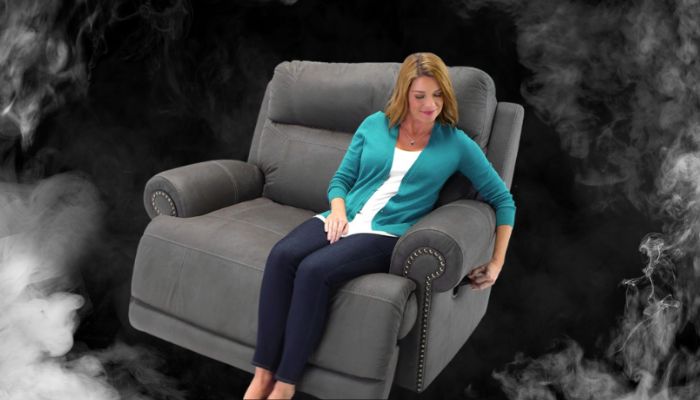Oversized recliners are becoming increasingly popular among people looking for a comfortable and relaxing way to unwind after a long day. These recliners are designed to be larger than standard recliners, providing more room for the user to stretch out and relax. However, some have raised concerns that oversized recliners may overheat, leading to discomfort or health risks.
One of the main concerns with oversized recliners is that they may trap heat, making them uncomfortably warm to sit in. This can be especially problematic when temperatures are already high in the summer. Additionally, some people may experience increased sweating or discomfort due to the heat generated by the recliner. This can be an issue for people with certain medical conditions, such as heat sensitivity or multiple sclerosis.
Another concern with oversized recliners is that they may not have adequate ventilation, which can lead to overheating. Many recliners are designed with a built-in ventilation system that helps to circulate air and keep the user cool. However, some oversized recliners may not have this feature, which can lead to overheating. This can be especially problematic for people who use the recliner for long periods, as the heat can build up over time.
And today, in this post, we will be jotting down everything you need to know regarding this situation. Read onwards!
So, Can Oversized Recliners Overheat?
Unfortunately, the answer is yes, it’s possible. However, it’s important to note that not all oversized recliners are created equal. Many manufacturers have addressed these concerns by designing their recliners with features such as built-in ventilation systems and breathable fabrics. Additionally, many oversized recliners are made with heat-dissipating materials that help dissipate heat and keep the user cool.
Another essential factor to consider is the location of the recliner. If you plan to place your oversized recliner in a room with poor ventilation or a high level of sunlight, it may be more prone to overheating. In such a case, it’s important to consider moving the recliner to a different room or placing it in a shaded area to reduce the risk of overheating.
These Are The Few Reasons Behind Why Such Things Takes Place:
Below we will list the top three reasons why overlined recliners get overheated. Take a look:
1: Trapping of heat
The first reason why your recliners are getting overheated can be the trapping of heat that is happening due to the overloaded stuff your recliner is carrying. In order to get rid of this, you may need to remove the extra stuff from the recliner, such as cushions, blankets, and sheets.
2: Lack of ventilation
Lack of ventilation is quite similar to trapping heat, as it represents the way low oxygen levels can cause wetness on foams and other clothing products. You may experience shortness of breath, headaches, and fatigue because it is made of carbon dioxide and little oxygen.
3: Long periods of use
The last thing that can cause your oversized recliners to overheat is long periods of use. Maybe the recliner that has been serving you the best for years now needs to be replaced, as it has already given you a lot. Let it go.
Factors That Can Exacerbate The Risk Of Overheating
Scroll down and get available with the things you need to stop to reduce the risk of exacerbating overheating:
1: Room ventilation
Room ventilation can REALLY exacerbate the risk of overheating. And to reduce the risk of making it happen, try to keep your room temperature normal, which means you should take care about how warm air inside a room is constantly replaced by mint air from outdoors.
2: Sunlight exposure
Sunlight exposure usually damages recliners, which leads them to hit their heating levels in a few minutes only. Moreover, according to the latest studies, raises of sun are also extremely harmful to such things that are made with foam and polyester.
3: Medical conditions
Last but not least, you have to make sure that your medical condition is perfect. This is because many people have sweating issues themselves, which might cause your recliners to overheat.
Here Are A Few Solutions To Prevent Overheating
Finally, now you can discover the top four ways to prevent overheating! Have a look below:
1: Built-in ventilation systems
The first option to prevent overheating resembles the first option we stated above. You just have to make sure that your house or the place you are keeping your recliners has Built-in ventilation systems so that the air which is replaced by mint air from outdoors doesn’t affect the recliner.
2: Breathable fabrics
You can also choose to make your recliners more comfortable by choosing fabrics that are breathable. You simply need to wrap that overly-stuffed couch with a great fabric, and you will be good to go!
3: Heat-dissipating materials
Heat-dissipating materials can do wonders only if you know how to keep them balanced. These materials take good particles with high thermal conductivity, which can make your oversized recliners overheat less and work longer than usual.
4: Proper location of the recliner
Here’s a thing, if you are placing your recliner at a proper location, it will never overheat before at least fifteen years. The ideal place is the corner of the room where two walls meet or the end of the chamber, where you can keep your recliner safe from the outside air and stuff.
Summing Up!
In conclusion, while oversized recliners can overheat, this is not a universal issue. Many manufacturers have addressed this concern by designing their recliners with features such as built-in ventilation systems and breathable fabrics. Additionally, by considering the location of the recliner, it can be ensured that it is placed in a well-ventilated area.
It is also important to keep in mind that it’s always a good idea to take regular breaks if you’re using your recliner for long periods of time, to avoid heat buildup and discomfort.

Welcome, I am Jerry Harper. I provide plus-size accessories encompassing swimwear, treadmills, bathing, and shoes. and more. I specialise in crafting innovative concepts that captivate readers within the dynamic landscape of plus-size fashion trends.
